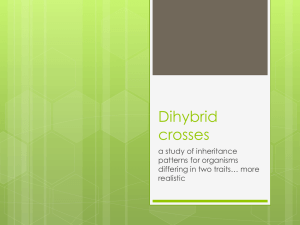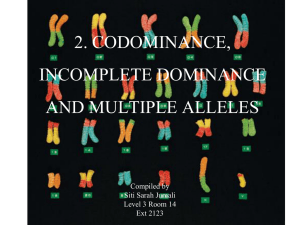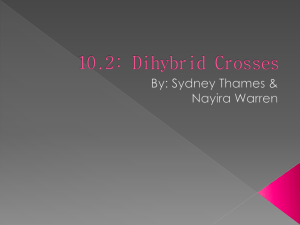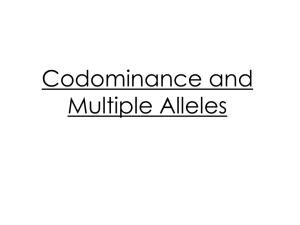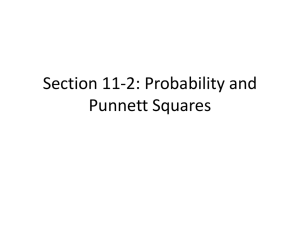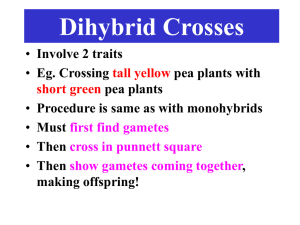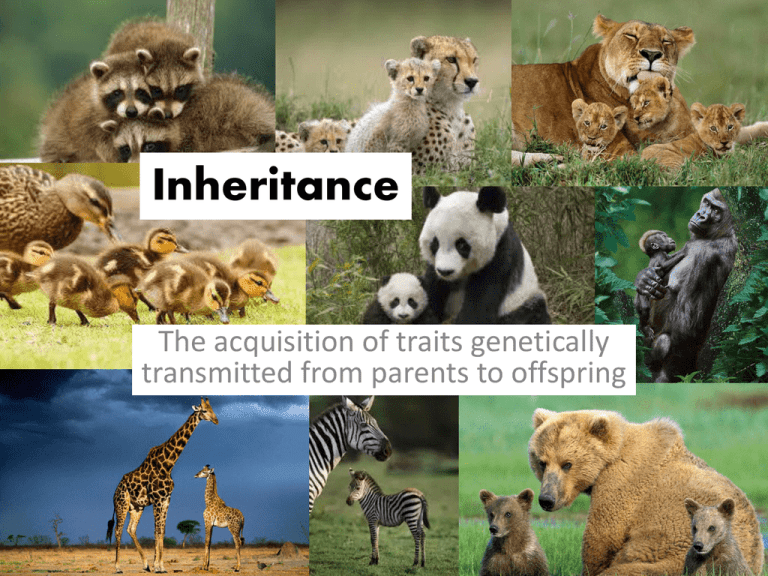
Inheritance
The acquisition of traits genetically
transmitted from parents to offspring
Inheritance
The next section of this unit involves
understanding the different ways in which genes
are passed from parents to offspring and how
the genotype is expressed in the phenotype.
It is very important to remember that
fertilisation is random, so when we predict
offspring ratios, we are talking about
likelihoods, not actual individuals.
Types of Inheritance
• Monohybrid Inheritance:
– Complete dominance
– Co-dominance
– Incomplete dominance
– Lethal alleles
– Multiple alleles
• Dihybrid Inheritance
Important Vocab
• Monohybrid – the cross between parents at a
single gene locus.
• Gene
• Allele
• Genotype
• Phenotype
• Dominant allele
• Recessive allele
• Homozygous
• Heterozygous
Judgy Owl wants you to know these definitions by heart.
Mendelian Genetics
• The types of inheritance we are looking at are
often referred to as Mendelian inheritance,
after Gregor Mendel.
• They refer to discontinuous variation, where
single genes produce phenotypes which have
discrete classes e.g. red vs. white.
• In contrast, continuous variation is the result
of many genes working together and produces
a spectrum of phenotypes e.g. skin colour
Continuous or discontinuous?
•
•
•
•
•
•
Skin colour
Earlobe attachment
Sex
Height
Hairiness
Tongue rolling
•
•
•
•
•
•
The interaction between genes
and the environment is
much more obvious in continuous
traits.
Hitchhikers thumb
Nose width
Tooth gap
Hair colour
Puberty age
Shoe size
Mendelian Genetics
• Gregor Mendel was
an Austrian monk
who first developed
the theory of genetic
inheritance from his
observations of
complete dominance
in pea plants.
• http://www.youtube.
com/watch?v=GTiOE
TaZg4w
Mendelian Genetics
• Pea plants show complete dominance in the
following traits:
– Purple vs. white flowers
– Axial vs. terminal flowers
– Long vs. short stems
– Round vs. wrinkled seeds
– Yellow vs. green seeds
– Inflated vs. constricted pods
– Yellow vs. green pods
Types of Inheritance
• Monohybrid Inheritance:
– Complete dominance
– Co-dominance
– Incomplete dominance
– Lethal alleles
– Multiple alleles
• Dihybrid Inheritance
Complete Dominance
• One allele is completely dominant over the
other.
• Heterozygous individuals are called “carriers”
because they carry a hidden allele that they
do not express but may pass on to offspring.
Complete Dominance
• We can predict offspring genotype and
phenotype ratios using Punnett Squares.
• Again, the ratios we get from our Punnett
squares are a probability estimate NOT the
actual exact number and order of offspring
produced by every mating.
Complete Dominance
• How to do a Punnett Square.
• 1) Choose a letter to represent the gene
(something where big and little letters look
quite different works best, e.g. Gg or Dd not
Cc)
• 2) Write down which trait is expressed by the
dominant and by the recessive allele beside
their big or little letter. Dominant allele is big,
recessive is little.
Complete Dominance
• 3) Decide what the genotype of each parent is
and write it down.
• 4) Draw their gametes underneath this.
• 5) Put the gametes (one letter per box) around
the outside of your Punnett Square.
• 6) Fill in the boxes.
• 7) Calculate the offspring genotype ratio.
• 8) Calculate the offspring phenotype ratio.
Complete Dominance
• In rabbits, black fur is dominant over white fur.
Show the cross of a heterozygous black male with
a homozygous white female.
B – black, b - white
B
b
• Key:
• Parents & gametes:
Bb
bb
b
Bb
B
x
b
bb
b
b
• Offspring genotype ratio:
• Offspring phenotype ratio:
b
Bb
1 Bb : 1 bb
1 Black : 1 White
bb
Complete Dominance
• In some cases, it is important to know the
genotype of an animal.
• Pure-breeding animals are homozygous for a
trait.
e.g. A cow could be pure-breeding for
the recessive trait of horns.
Genotype = hh
How could you tell what the genotype of a
hornless bull was?
Complete Dominance
• A test cross is when you breed an animal
showing a dominant phenotype (with an
unknown genotype) with a recessive
individual.
– If offspring with a recessive phenotype are
produced, the individual must be heterozygous.
– If no recessive offspring are produced in several
matings, the individual can be assumed to be
homozygous dominant and included in breeding
programs as a pure-breeding individual.
Complete Dominance
• Test cross
• Key
Test cross shows that the
male is heterozygous.
H – hornless, h - horns
H
• Parents and gametes
H?
H
x
?
hh
h
h
• Offspring genotype ratio: 1 Hh :
• Offspring phenotype ratio:
h
h
Hh
hh
h
Hh
hh
1 hh
1 Hornless: 1 Horned
Complete Dominance
Test cross shows that the
male is homozygous.
He can be used in the
breeding program because
he is pure breeding.
• Test cross
• Key
H – hornless, h - horns
H
• Parents and gametes
H?
H
x
?
hh
h
h
• Offspring genotype ratio: All Hh
• Offspring phenotype ratio:
H
h
Hh
Hh
h
Hh
Hh
All hornless
Types of Inheritance
• Monohybrid Inheritance:
– Complete dominance
– Co-dominance
– Incomplete dominance
– Lethal alleles
– Multiple alleles
• Dihybrid Inheritance
Co-dominance
• Some traits show a type of inheritance called
co-dominance.
• Co-dominance means both alleles are equally
dominant so BOTH are shown in heterozygous
individuals.
• Two different capital letters are used to
symbolise equally dominant alleles.
• Three different phenotypes can be produced.
Co-dominance
• Both alleles are shown in the phenotype of
heterozygotes.
WB
WW
BB
Co-dominance
• Both alleles are shown in the phenotype of
heterozygotes.
RR
RW
“Roan”
WW
Co-dominance
• Both alleles are shown in the phenotype of
heterozygotes.
WW
RW
RR
Co-dominance
• How do you spot an example of codominance?
– Three alleles are produced
– The heterozygote condition is to show both alleles
equally e.g. the coat contains red hairs AND white
hairs.
Types of Inheritance
• Monohybrid Inheritance:
– Complete dominance
– Co-dominance
– Incomplete dominance
– Lethal alleles
– Multiple alleles
• Dihybrid Inheritance
Incomplete Dominance
• This is like co-dominance, in that three alleles
are produced.
• BUT instead of the heterozygote showing both
alleles equally, the heterozygote phenotype is
a blend of both alleles.
• We use the complete dominance system of
two letters to show incomplete dominance
even though one isn’t dominant over the
other.
Incomplete Dominance
• The heterozygote phenotype is an
intermediate blend of the other two.
RR
Rr
rr
Incomplete Dominance
• The heterozygote phenotype is an
intermediate blend of the others.
cc
Cc
CC
Incomplete Dominance
• The heterozygote phenotype is an
intermediate blend of the others.
BB
Bb
bb
Incomplete vs. Co-dominance
• Be VERY careful when reading the description
of phenotypes.
• If it says the animals look an intermediate
colour, is it
– Because it makes equal numbers of each
Co-dominance
hair/feather colour?
– Because all the hairs/feathers are an intermediate
colour?
Incomplete dominance
Which is which?
Types of Inheritance
• Monohybrid Inheritance:
– Complete dominance
– Co-dominance
– Incomplete dominance
– Lethal alleles
– Multiple alleles
• Dihybrid Inheritance
Lethal Alleles
• Lethal alleles occur when a mutation results in
an allele that produces a non-functional
version of an essential protein.
• If an individual inherits a lethal combination of
mutated alleles, it will die before or shortly
after birth.
• This will alter the expected offspring ratios.
Lethal Alleles
• In fruit flies, a mutated dominant allele
produces curly wings (C) instead of normal (c).
CC
Cc
• Homozygous dominant (CC) flies do not
survive.
cc
Lethal Alleles
• With a heterozygous cross, we expect a 3:1
phenotype ratio.
C
c
C
c
CC
X
Cc
Cc
cc
• BUT, because the homozygous dominant
individuals die, the ratio becomes
2 curly:1 normal
Types of Inheritance
• Monohybrid Inheritance:
– Complete dominance
– Co-dominance
– Incomplete dominance
– Lethal alleles
– Multiple alleles
• Dihybrid Inheritance
Multiple Alleles
• Multiple allele inheritance occurs when a gene
has more than two alleles.
• Each individual still only has two copies of the
gene.
• The most well-known example of multiple alleles
is human blood groups, which show BOTH codominance AND complete dominance.
Multiple Alleles
• IA and IB can be codominant, giving
blood type AB.
• IA and IB are
completely dominant
to i, producing type A
(IAi) and type B (IBi).
• ii is the homozygous
recessive type O.
I
II
I
II
I I
Multiple Alleles
• Antibodies identify foreign
objects and attack them.
• Type AB has no antibodies,
so can accept blood from
anyone.
• Type O has both anti-A
and anti-B antibodies so
can only get blood from
type O.
• Type A has anti-B and Type
B has anti-A antibodies.
I
II
I
II
I I
Exam Question
• An example of multiple alleles is one that determines the
feather pattern of mallard ducks. One allele M, produces
the wild-type mallard pattern. A second allele MR,
produces a different pattern called restricted, and a third
allele, md, produces a pattern termed dusky.
• In this series, restricted is dominant over mallard and
dusky, and mallard is dominant over dusky:
MR
>
M
>
md
Exam Question
• There are six genotypes possible with these three alleles to
produce the three phenotypes.
• Discuss why there is only one combination of parental
genotypes which can produce offspring that show all three
phenotypes in the F1 offspring.
• In your answer you should complete the Punnett square to
show the cross, and clearly identify the genotype and
phenotype proportions expressed as a percentage or ratio.
Refer to your completed Punnett square in your discussion.
Exam Question
MR
md
M MRM Mmd
md MRmd mdmd
Parents: MRmd x Mmd
Genotype ratio: 1MRM: 1Mmd: 1MRmd : 1mdmd
Phenotype ratio: 2 restricted : 1 mallard : 1 dusky
Only this cross will produce all three phenotypes because in
order for the homozygous recessive dusky phenotype to be
expressed, both parents must carry a recessive allele.
If they both have a recessive allele, then to produce the
mallard and restricted phenotypes, one parent must carry the
dominant MR allele to produce restricted offspring and the
other must carry the dominant M allele to produce mallard
offspring.
As indicated by the Punnett square, this should result in an
offspring ratio of 2 restricted: 1 mallard : 1 dusky offspring.
Types of Inheritance
• Monohybrid Inheritance:
– Complete dominance
– Co-dominance
– Incomplete dominance
– Lethal alleles
– Multiple alleles
• Dihybrid Inheritance
Dihybrid Inheritance
• So far we have been looking at monohybrid
inheritance: the inheritance patterns of ONE
gene.
• With dihybrid inheritance, we look at TWO traits
controlled by TWO genes and see how they are
inherited together.
• They may be on the same chromosome (LINKED
GENES) or not (unlinked genes).
Dihybrid Inheritance
• Because we are looking at two genes, we now have
two letters in each gamete and four letters to represent
offspring.
• For example, pea gametes will have a gene for height
AND a gene for seed colour.
T = tall, t = short
Y = yellow seed, y = green seed
• Pea offspring will have two copies of each gene, one
from each parent.
Dihybrid Inheritance
• If we have parents (the P generation) which
are pure-breeding tall & yellow (TTYY) and
pure-breeding short and green (ttyy), their
offspring (the F1 generation) look like this:
TTYY
x
ttyy
F1 (first filial) generation
TY
TY
ty
ty
Note: Pollen don’t have tails but it
helps to see them anyway.
TtYy
All F1 offspring are TtYy
Tall and yellow seed
Dihybrid Inheritance
• Crossing these offspring produces an F2 generation.
Because they are all heterozygous, there are four
possible gamete produced by each offspring.
TtYy
TY
TtYy
Ty
Ty
tY
ty
F2 (second filial) generation
TY
TY
Ty
tY
ty
TY
TTYY
TTYy
TtYY
TtYy
tY
Ty
TTYy
TTyy
TtYy
Ttyy
ty
tY
TtYY
TtYy
ttYY
ttYy
ty
TtYy
Ttyy
ttYy
ttyy
Dihybrid Inheritance
• A dihybrid heterozygous cross results in a
9:3:3:1 phenotype ratio.
3 Short &
Yellow
3 Tall &
Green
9 Tall &
Yellow
1 Short &
Green
TY
Ty
tY
ty
TY
TTYY
TTYy
TtYY
TtYy
Ty
TTYy
TTyy
TtYy
Ttyy
tY
TtYY
TtYy
ttYY
ttYy
ty
TtYy
Ttyy
ttYy
ttyy
Dihybrid Cross
• TWO traits
• Tail length:
S – short tail
s – long tail
• Coat colour
B – brown coat
b – white coat
Again, 9:3:3:1 is the offspring phenotype ratio
from a dihybrid heterozygous cross.
Dihybrid Cross
• What about non-heterozygous crosses?
• TWO traits
• Tail length:
S – short tail
s – long tail
• Coat colour
B – brown coat
b – white coat
Brown long tail x White short tail
Bbss
bbSs
Bs
bs
bS
bs
Bs
bs
bS
BbSs
bbSs
bs
Bbss
bbss
Offspring genotype ratio= 1 BbSs : 1 bbSs : 1 Bbss : 1 bbss
Offspring phenotype ratio = 1 brown short : 1 white short : 1 brown long : 1 white long
Dihybrid Cross
• If there is no linkage, the offspring ratio
predicted by our Punnett squares should be
quite close to observed offspring ratios (if
there are lots of offspring).
• BUT if the genes are on the same allele, it is
no longer random which gametes are likely to
be produced.
Dihybrid Cross
DdEe x
D
E
DE
DE
de
DdEe
• This shows a dihybrid heterozygote
cross.
DdEe x DdEe
• We expect a 9:3:3:1 ratio. BUT
because the genes are on the
same chromosome, the alleles are
linked.
• Instead of 4 different gametes (DE,
De, dE, de), each parent only
produces 2 kinds = DE and de.
de DE
de • So our offspring phenotype ratio is
now 3 dominant: 1 recessive
DE
de
• This is not the 9:3:3:1 we
DDEE
DdEe
expected, so we know the genes D
and E are linked.
DdEe
ddee
d
e
D
E
d
e
Dihybrid Cross
• Just like we do a test cross to find the
genotype of an unknown dominant animal by
breeding it with a recessive animal, we can
breed a double heterozygous animal with a
recessive animal to measure the effects of
crossing over.
chromosome
Crossing Over
A
A
a
a
A
A
a
a
B
B
b
b
B
B
b
b
C
C
c
c
C
C
c
c
chromatid
centromere
D
D
d
d
D
D
d
d
E
E
e
e
E
E
e
e
F
f
F
f
G
g
G
g
F
f
G
g
chiasma
Dihybrid Cross
• In maize:
Y= yellow, y = colourless
F = full cob, f = wrinkled cob.
• Calculate the expected phenotype ratio of a
double heterozygote x double recessive cross.
YyFf
YF
yf
Yf
yF
x
yf
yyff
x
yf
YF
Yf
yF
yf
YyFf
Yyff
yyFf
yyff
Expected ratio
1 yellow full:
1 yellow wrinkled:
1 colourless full:
1 colourless wrinkled
Dihybrid Cross
• The observed ratio was actually
48% yellow: 2% yellow: 2% colourless : 48% colourless
full
wrinkled
full
wrinkled
How come?
Crossing over has occurred, producing lots more
of the yellow-full and colourless-wrinkled types
than expected. These “extra” individuals are
recombinants.
Because so many show recombination, we
would expect these genes to be quite far apart.
chromosome
Crossing Over
A
A
a
a
B
B
b
b
C
C
c
c
D
D
d
d
E
E
e
e
F
f
G
g
On these chromosomes, you
would expect crossing over to
happen more often between
far apart genes.
chromatid For example, there are lots of
places chiasmata could occur to
separate genes A and G.
centromere But to separate F and G the
chiasmata would have to be
very specific, so we would
expect these to be separated
less often.
In this way, scientists are able
chiasma
to estimate where different
genes lie on a chromosome. It
is called chromosome
mapping.
Types of Inheritance
• Monohybrid Inheritance:
– Complete dominance
– Co-dominance
– Incomplete dominance
– Lethal alleles
– Multiple alleles
• Dihybrid Inheritance
In your books, write
yourself a cheat
sheet which tells you
how to recognise
each type of
inheritance.
e.g. Complete
dominance = two
alleles, heterozygote
cross is 3:1 ratio.

